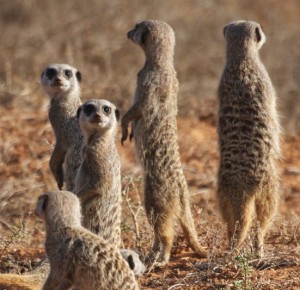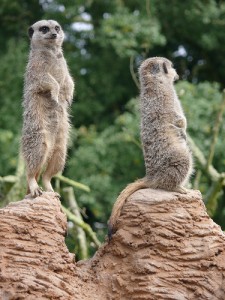The “Sentry” Meerkats
Meerkats (Suricata suricatta), also called suricates, are one of the commonest mammals in South Africa which belong to the mongoose family. Famous for their upright posture (standing on their rear legs and gaze alertly at the surrounding), these gregarious small meerkats (Suricata suricatta) are good hunters and they always hunt in large groups. They tend to come out and hunt at certain time of the day, avoiding high and low temperature.
What I find very interesting about their foraging pattern is the altruistic behaviour within their colonies. As they are vulnerable, a few of them in the groups will come out to ensure the surrounding is safe before they hunt. “Sentry” is employed at vantage positions like small trees and rocks where they have a wide field of view. I’m really amused at their ability to do so. It is similar to humans doing sentry duty, keeping a lookout to any dangers approaching. They are able to work and communicate with one another through the use of their sharp and shrill call as a signal to take cover when there are predators like eagles and hawks. While a few of them are keeping a lookout, the rest will forage for foods that make up their varied diet.
They eat mostly insects, lizards and other small invertebrates which are dug up with their long claws of the fore feet. Their abilities to scratch the ground using their long sharp claws (fixed action pattern) and to smell for insects allow them to find food buried deep under the ground. They are even immune to the poisonous venom from the scorpions of the Kalahari Desert!
Meerkats (Suricata suricatta) have one of the most interesting and unique foraging behaviours I discovered so far. They may look cute and adorable but when hunting for food, they can be become a menacing mob!
An interesting video on how the meerkats (Suricata suricatta) forage for food during dinner time.
World’s Deadliest : Meerkats’ Mob Rule
References:
“World’s Deadliest : Meerkats’ Mob Rule,” by NatGeoWild YouTube Channel, 4 Mar 2013.
URL: http://www.youtube.com/watch?v=D8JKXlTY70g (accessed on 2 Apr)
“Otters and Meerkats: World’s Deadliest: Meerkat Mob”. National Geographic.
URL: http://video.nationalgeographic.com/video/animals/mammals-animals/otters-and-meerkats/deadliest-meerkats/?utm_source=Facebook&utm_medium=Social&utm_content=link_fb20130325video-meerkat&utm_campaign=Content (accessed on 2 Apr 2013)
“Meerkat (Introduction)”. BBC.
URL: http://www.bbc.co.uk/nature/life/Meerkat#intro (accessed on 3 Apr 2013)
“Meerkat groups have ‘traditions’”. BBC, 7 July 2010.
URL: http://www.bbc.co.uk/news/10529154 (accessed on 3 Apr 2013)
“Meerkat, Suricata suricatta”. National Geographic.
URL: http://animals.nationalgeographic.com/animals/mammals/meerkat/ (accessed on 2 Apr)
Manser, M.B., H.P. Kunc, J.R. Madden, S. English and T.H. Clutton-Brock, 2008. Signals of need in a cooperatively breeding mammal with mobile offspring. Animal Behaviour 76(6): 1805-1813.
S. P. Doolan and D. W. Macdonald, 1996. Diet and foraging behaviour of group-living meerkats, Suvicata suricatta, in the southern Kalahari. Journal of Zoology 239(4): 697-716.
R. F. Ewer, 1963. The Behaviour of the Meerkat, Suricata suricatta (Schreber). Zeitschrift für Tierpsychologie 20(5): 570-607
“p1210564,” by generalising. Flickr, 24 August 2008.
URL: http://www.flickr.com/photos/shimgray/2797343674/ (accessed on 4 Apr)
“Meerkats,” by mmmavocado. Flickr, 25 July 2008.
URL: http://www.flickr.com/photos/mmmavocado/2745828979/ (accessed on 4 Apr)


This is very useful information about meercats. Thank you.s very useful information about meercats. Thank you.